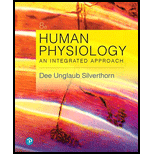
Concept explainers
a.
To determine: The difference between lymphatic and systemic capillaries.
Introduction: The lymphatic system consists of lymphatic organs, lymphatic ducts, nodes, and vessels. The lymphatic organs are divided into two, the primary lymphoid organs and the secondary lymphoid organs. The primary organs serve as the maturation site for lymphocytes while the secondary organs serve as the differentiation site.
b.
To determine: The difference between the role of the sympathetic and parasympathetic nervous system in blood pressure control.
Introduction: Arterial blood pressure is the pressure applied by the flowing blood inside the arteries of the body. The blood pressure is regulated by several factors that can increase or decrease the blood pressure depending upon the requirement of the body.
c.
To determine: The difference between lymph and blood.
Introduction: The lymphatic system consists of lymphatic organs, lymphatic ducts, nodes, and vessels. The cardiovascular system is made of different components. The heart constitutes the primary organs of the system, and the arteries, veins and blood capillaries form the associated structures of the cardiovascular system.
d.
To determine: The difference between continuous and fenestrated capillaries.
Introduction: The cardiovascular system is made of different components. The heart constitutes the primary organs of the system, and the arteries, veins, and blood capillaries form the associated structures of the cardiovascular system. Among the blood vessels, the pulmonary artery, vein, and aorta form the largest and most important vessel system.
e.
To determine: The difference between hydrostatic pressure and colloid osmotic pressure in systemic capillaries.
Introduction: Hypertension is the condition where the blood pressure of the individual in constantly high due to the increased pressure of blood against the arteries supplying blood to the heart. Hypertension can arise due to narrowing of the lumen of the arteries because of fat deposition.
Want to see the full answer?
Check out a sample textbook solution
Chapter 15 Solutions
Human Physiology: An Integrated Approach (8th Edition)
- Please identify the curve shown below. What does this curve represent? Please identify A, B, C, D, and E (the orange oval). What is occurring in these regions?arrow_forwardPlease identify the test shown here. 1) What is the test? 2) What does the test indicate? How is it performed? What is CX? 3) Why might the test be performed in a clinical setting? GEN CZ CX CPZ PTZ CACarrow_forwardDetermine how much ATP would a cell produce when using fermentation of a 50 mM glucose solution?arrow_forward
- Determine how much ATP would a cell produce when using aerobic respiration of a 7 mM glucose solution?arrow_forwardDetermine how much ATP would a cell produce when using aerobic respiration to degrade one small protein molecule into 12 molecules of malic acid, how many ATP would that cell make? Malic acid is an intermediate in the Krebs cycle. Assume there is no other carbon source and no acetyl-CoA.arrow_forwardIdentify each of the major endocrine glandsarrow_forward
- Come up with a few questions and answers for umbrella species, keystone species, redunant species, and aquatic keystone speciesarrow_forward19. On the diagram below a. Label the three pictures as: DNA; polypeptide; or RNA. b. Label the arrows as: translation or transcription/RNA processing. c. Add the following details to the diagram. Promoter region TATA box Transcription start site Transcription terminator Intron (A,B,C,D) Exons (1,2,3,4,5) Splice sites 5' cap 5' UTR (untranslated region) 3' poly A tail 3' UTR (untranslated region) Translational start (AUG) Translational stop (UGA, UAG, or UAA) N and C ends of polypeptide 0000arrow_forwardMatch the letter labels in the figure below to the terms. Some letter labels are not used. MNNNNNNIN M C B A M D F E H K G 8arrow_forward
 Human Physiology: From Cells to Systems (MindTap ...BiologyISBN:9781285866932Author:Lauralee SherwoodPublisher:Cengage Learning
Human Physiology: From Cells to Systems (MindTap ...BiologyISBN:9781285866932Author:Lauralee SherwoodPublisher:Cengage Learning Medical Terminology for Health Professions, Spira...Health & NutritionISBN:9781305634350Author:Ann Ehrlich, Carol L. Schroeder, Laura Ehrlich, Katrina A. SchroederPublisher:Cengage Learning
Medical Terminology for Health Professions, Spira...Health & NutritionISBN:9781305634350Author:Ann Ehrlich, Carol L. Schroeder, Laura Ehrlich, Katrina A. SchroederPublisher:Cengage Learning Human Biology (MindTap Course List)BiologyISBN:9781305112100Author:Cecie Starr, Beverly McMillanPublisher:Cengage Learning
Human Biology (MindTap Course List)BiologyISBN:9781305112100Author:Cecie Starr, Beverly McMillanPublisher:Cengage Learning Comprehensive Medical Assisting: Administrative a...NursingISBN:9781305964792Author:Wilburta Q. Lindh, Carol D. Tamparo, Barbara M. Dahl, Julie Morris, Cindy CorreaPublisher:Cengage Learning
Comprehensive Medical Assisting: Administrative a...NursingISBN:9781305964792Author:Wilburta Q. Lindh, Carol D. Tamparo, Barbara M. Dahl, Julie Morris, Cindy CorreaPublisher:Cengage Learning Fundamentals of Sectional Anatomy: An Imaging App...BiologyISBN:9781133960867Author:Denise L. LazoPublisher:Cengage Learning
Fundamentals of Sectional Anatomy: An Imaging App...BiologyISBN:9781133960867Author:Denise L. LazoPublisher:Cengage Learning





